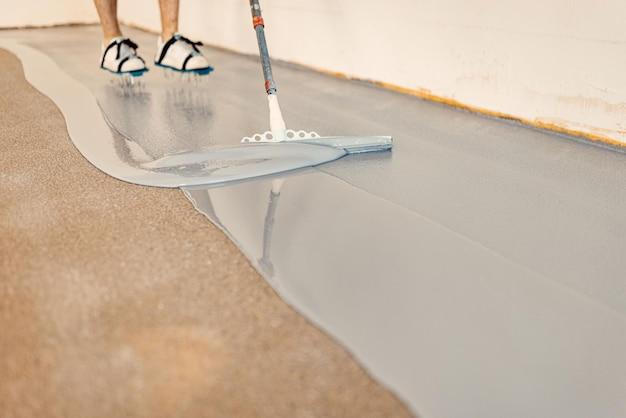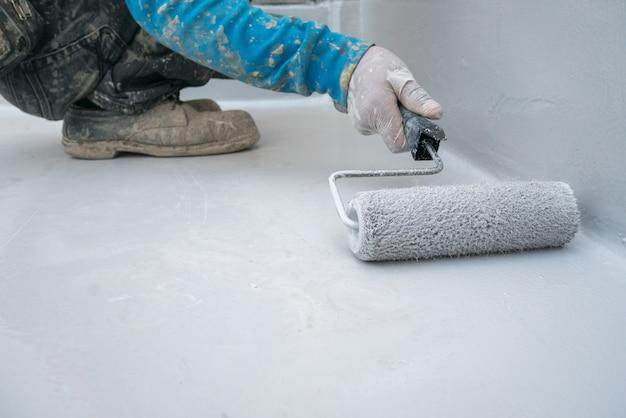Are you looking to give your car or any other metal surface a professional paint job? If so, then you’ve probably heard of epoxy primer. Epoxy primer is a popular choice among auto enthusiasts and professional painters because of its excellent adhesion and corrosion resistance properties. But when it comes to top coating, timing is everything.
In this blog post, we’ll explore the important question of how soon can you top coat epoxy primer. We’ll also delve into related queries such as how long epoxy primer takes to dry, whether you need to sand it before applying a top coat, and what happens if you paint over primer too soon. So, if you’re eager to learn more about the timing and techniques involved in using epoxy primer, you’ve come to the right place!
How Soon Can You Apply a Top Coat to Your Epoxy Primer
So, you’ve painstakingly applied an epoxy primer to your project and now you’re eager to move on to the next step – top coating! But hold your horses! Before you rush into slapping on that top coat, it’s important to consider the curing time of your epoxy primer. You wouldn’t want to jeopardize all your hard work, would you? Let’s dive into the fascinating world of epoxy primers and find out just how soon you can apply a top coat.
Understanding the Curing Process
Before we get into the nitty-gritty details, let’s take a quick moment to understand the curing process of epoxy primer. When you apply epoxy primer, it forms a protective film that bonds to the surface. This film undergoes a chemical reaction known as curing, where it hardens and becomes durable. The curing time varies depending on factors such as temperature, humidity, and the specific product you’re using.
Patience is a Virtue
Now, I know waiting for things to dry can be as agonizing as waiting for the next season of your favorite TV show, but trust me when I say that patience is a virtue in the world of epoxy primers. Rushing the process and applying a top coat too soon can lead to catastrophic results. Nobody wants a top coat that never fully adheres or peels off like a bad sunburn, right? Right.
Waiting is Worth It
So, how long should you wait before applying that top coat to your freshly applied epoxy primer? Well, it depends on the specific product you’re using. Manufacturers usually provide guidelines on the recommended curing time, which is typically mentioned on the product label or in the technical data sheet. In general, you can expect to wait anywhere from 24 to 72 hours before top coating. Remember, good things come to those who wait!
The Waiting Game Factors
Now, let’s talk about those factors that can influence the waiting game. Temperature plays a significant role in the curing process. Cooler temperatures slow down the curing time, while warmer temperatures speed it up. So, if you’re working in a chilly garage during the winter, be prepared to exercise a bit more patience. Humidity is another factor to consider. High humidity can also slow down the curing process, so try to choose a day with moderate humidity for optimal results.
Testing, Testing, 1-2-3
If you’re itching to apply that top coat but you’re unsure if the epoxy primer is fully cured, it’s always a good idea to conduct a simple test. Take a fingernail and gently press it into a small inconspicuous area of the primer. If it leaves a mark or indentation, it’s a clue that the primer is not fully cured yet. On the other hand, if it feels hard and there’s no visible mark, you’re good to go! Just don’t get too carried away with your newfound scratching abilities.
Conclusion
In conclusion, the waiting game is a crucial part of the epoxy primer process. It’s essential to give the primer enough time to fully cure before applying a top coat. Waiting for the recommended curing time, considering factors such as temperature and humidity, and conducting a simple test can ensure a successful and durable top coat. So, resist the temptation to rush the process and remember this golden rule: patience is the key to epoxy primer perfection.
FAQ: How Soon Can You Top Coat Epoxy Primer
How soon can I sand epoxy primer?
You’ll want to let the epoxy primer dry for at least 24 hours before sanding. This gives it enough time to fully cure and ensure a smooth surface for your top coat.
How long can I wait to paint after epoxy primer?
Ideally, you should paint within 7 days of applying the epoxy primer. After this period, the primer becomes less receptive to bonding with the top coat, which could affect the overall durability of your paint job. So, don’t procrastinate too long!
Can you use body filler over epoxy primer?
Absolutely! Epoxy primer creates a solid foundation for body filler, providing excellent adhesion. Just make sure the primer is fully cured and sanded to ensure a proper bond.
What happens if you paint over primer too soon?
Painting over primer that hasn’t fully cured can lead to a variety of issues, including poor adhesion, bubbling, and premature paint failure. Patience is key here – let the primer cure according to the manufacturer’s instructions before applying your top coat.
Can I use epoxy primer as a sealer?
Indeed! Epoxy primer can also be used as a sealer. Its high build and excellent adhesion properties make it suitable for sealing surfaces, creating a smooth, uniform substrate for subsequent layers of paint.
Can you epoxy primer over high build primer?
While it’s generally best to keep the layers in a specific order to ensure optimal performance, epoxy primer can be applied over high build primer. Just make sure to follow the manufacturer’s guidelines and allow for proper drying and sanding between coats.
How long does 2K epoxy primer take to dry?
2K epoxy primers typically take around 4 to 6 hours to dry to the touch. However, it’s essential to note that drying time can vary based on factors such as temperature, humidity, and film thickness. To be safe, it’s a good idea to wait 24 hours before applying your top coat.
Is epoxy primer a good sealer?
Absolutely! Epoxy primer’s sealing properties make it an excellent choice for providing a protective barrier against moisture, corrosion, and other environmental factors. Plus, it helps ensure a smoother and more durable finish for your top coat.
What is the difference between self etching primer and epoxy primer?
Self etching primers are designed to chemically bond with bare metal surfaces, creating a corrosion-resistant layer. On the other hand, epoxy primers offer superior adhesion and build, making them ideal for various substrates, including metal, fiberglass, and plastic. Choose the right primer based on your specific needs and surface type.
Do you have to sand epoxy primer before top coat?
Yes, it’s crucial to sand the epoxy primer before applying the top coat to enhance adhesion and create a smooth surface for your final paint job. Remember, smooth is the name of the game!
What do you reduce epoxy primer with?
To reduce (thin) epoxy primer, you can use specific epoxy reducers recommended by the manufacturer. These reducers help achieve the desired viscosity for better application and coverage. Remember, always follow the manufacturer’s instructions for the correct mixing ratios to maintain the primer’s quality.
Can I spray epoxy primer at home?
Certainly! You can spray epoxy primer at home, but proper ventilation and safety precautions are a must. Ensure you have adequate ventilation, wear protective gear such as goggles and a respirator, and follow the manufacturer’s instructions for application techniques and safety guidelines.
How do you know if epoxy primer is cured?
The best way to know if epoxy primer is cured is by checking the manufacturer’s recommended drying time. Once the specified time has elapsed, the primer should be touch-dry and no longer feel tacky. Take a gentle swipe with your finger – if it doesn’t leave a mark, you’re good to go!
How long should epoxy primer dry before top coat?
Epoxy primer should dry for a minimum of 24 hours before applying the top coat. However, depending on atmospheric conditions, film thickness, and manufacturer recommendations, it can sometimes take longer. Proper curing time ensures the primer achieves its full protective and bonding capabilities.
How long can you leave epoxy primer unpainted?
While epoxy primer provides some protection against the elements, it’s best not to leave it exposed for an extended period. Unpainted epoxy primer can be vulnerable to UV damage and may deteriorate over time. To maintain its integrity, it’s recommended to paint within 7 days of applying the primer.
How many coats of epoxy primer do I need?
Generally, one to two coats of epoxy primer are sufficient to achieve the desired results. However, factors such as surface condition, coverage, and personal preference can influence the number of coats needed. If you’re unsure, always consult the manufacturer’s recommendations for the best outcome.
Can you recoat epoxy primer?
Certainly! If you need to apply multiple coats of epoxy primer, it’s essential to follow the manufacturer’s instructions on recoating times. Applying additional coats within the recommended window ensures proper chemical bonding between layers, resulting in a stronger, more resilient finish.
Can you spray epoxy primer over old paint?
Yes, epoxy primer can be sprayed over old paint. It provides exceptional adhesion and can help create a smooth surface for your new paint job. However, it’s crucial to properly prepare the surface by removing any loose or flaking paint and ensuring good adhesion between the old paint and the primer.
Is it OK to leave primer unpainted?
While primer provides some protection for bare surfaces, leaving it unpainted is generally not recommended. Primer is designed to bond with the paint layers, providing adhesion and durability. Painting over the primer helps seal it and provides the necessary weather resistance and aesthetic appeal.
How long can you leave a car in epoxy primer?
If you’ve carefully prepped and applied epoxy primer to your vehicle, you can leave it in this state for an extended period, provided you protect it from excessive moisture and sunlight. However, to ensure optimal protection and a finished look, it’s best to paint your car within 7 days of applying the primer.
How long can you leave primer unpainted?
Leaving primer unpainted can compromise its protective properties, especially for extended periods. While primer can offer some short-term protection, it’s best to apply the finishing paint as soon as possible to maintain the designated timelines and ensure optimal durability.
Can you put a top coat over epoxy primer?
Absolutely! Once the epoxy primer has fully cured, you can apply your desired top coat. The top coat adds an additional layer of protection, durability, and aesthetics to your project, giving it that extra shine and finishing touch.
How long after priming can you top coat?
To ensure a successful top coat, it’s generally recommended to wait 24 hours after priming before applying your final coat. This waiting period allows the primer to fully cure and create an optimal bonding surface for the top coat. Patience pays off when it comes to achieving a flawless finish!
What happens if you don’t paint over primer?
If you neglect to paint over primer, it will gradually deteriorate and lose its protective properties. Unpainted primer is susceptible to UV damage, moisture penetration, and general wear and tear. So, don’t leave it exposed – give it the coat of paint it deserves!
That wraps up our FAQ section on how soon you can top coat epoxy primer. Hopefully, this has cleared up any lingering questions you had. Remember, always follow the manufacturer’s instructions and take your time to achieve a professional finish. Happy painting!

